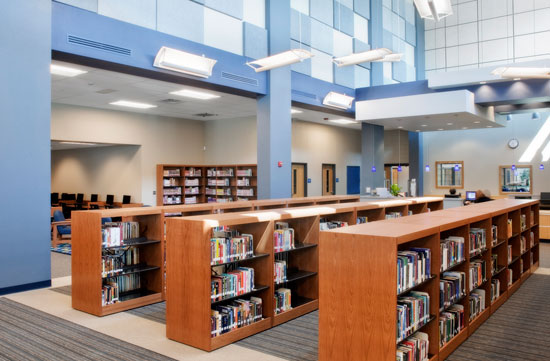Use Cementitious Wood Fiber for Great Acoustical Design
Acoustical Wall and Ceiling Panels
CWF acoustical wall panels and ceiling panels are literally panels of the sound-absorbing CWF compound. These panels are placed on walls or in the ceiling of gymnasiums, auditoriums, schools, open office spaces, hotel lobbies, multi-use spaces and any public space where improved acoustical performance is necessary. They actively absorb sound waves that are present and convert the sound energy into small amounts of heat, controlling the overall level of noise in a space and diminishing the opportunities for sound distortion from interference and echoes.
These panels are available in a variety of sizes, shapes, and decorative finishes to best match the aesthetic and sound absorption needs of the space. Panels can be used in their natural wood color, painted, or wrapped in fabric.
Ceiling-Mount Options
Ceiling-mounted acoustical panels can be specified as direct-attached, lay-in, or cloud panels. Direct-attach panels offer a unique ceiling aesthetic, without the use or appearance of a ceiling grid, and can be mechanically attached to a variety of ceiling substrates that include: the joists, the underside of the roof deck, drywall suspension systems, metal and wood furring structures and other commonly used support systems. Lay-in ceiling panels are easily installed in standard ceiling grid systems. Cloud panels and baffles offer acoustical design solutions in areas where a ceiling grid is not practical. These cloud panels and baffles are designed to accommodate a floating system with no visible suspension and are rapidly gaining adoption in open plenum systems.
Compare CWF Panels with Other Acoustic Materials
Acoustical wall and ceiling treatments are available in many different types of materials, including fiberglass, foam, and perforated metal, but only the CWF products offer the benefit blend of excellent sound absorption, durability, fire resistance, and aesthetic appeal in a truly sustainable solution.

At Lampasas High School in Lampasas, Texas, color is used as an aesthetic complement to the other benefits of excellent sound absorption, durability, fire resistance, and a textural aesthetic appeal.
Foam
Perhaps the most basic acoustical panel solution is manufactured from acoustical foam. These panels are often non-decorative and regularly found in industrial applications, where aesthetic design is not a concern. In their most basic form, foam panels are not designed to withstand much daily abuse, making it risky to install them in school gymnasiums or any high traffic areas. Acoustical foam panels can also have a more limited functional range. While these products can absorb high and mid-range frequencies, they are not capable of absorbing bass frequencies lower than 500Hz. Before specifying acoustical foam, it will be important to verify the range of frequencies expected to be present in the space.
Fiberglass
Fiberglass is a material commonly used to absorb sound waves in wall and ceiling panel-based solutions. While it provides effective sound management and is able to accommodate a broad range of frequencies with relatively even absorption, the fiberglass material possesses some inherent physical weaknesses that compromise the overall durability of these panels. Made from silicon rock (glass) that has been melted and spun into wool, fiberglass panels are not readily able to withstand much abuse without denting or requiring some type of repair and the material can become brittle over time, making it increasingly fragile.
Perforated Metal
A perforated metal acoustical panel typically consists of a metal or aluminum frame surrounding a perforated metal skin that encapsulates acoustical fiberglass. The sound waves penetrate the perforations in the metal skin and are absorbed by the fiberglass inside. These panels can offer unique aesthetic appeal and the effective noise reduction provided by the fiberglass material in a solution that is more durable than a fiberglass panel with a fiberglass exterior. Perhaps the more glaring shortcoming of a perforated metal panel is its limited ability to contribute toward green building initiatives.
CWF
CWF acoustical panels provide fairly even absorption for a broad range of frequencies on the audio spectrum with NRC values nearing or equal to 1.00, indicating that the panels absorb 100 percent of the sound waves present within the range of 250Hz and 2,000Hz. They are available in a wide variety of designs and finishes. These formed wood-cement-mineral composites are incredibly tough and abuse resistant, easily withstanding the daily wear and tear that may occur in school gymnasiums, auditoriums, or corporate offices. CWF panels are flame resistant and have a Class A/I flame spread rating. These panels possess many sustainable characteristics and are often specified on LEED projects as they can contribute points to the LEED rating system on a variety of criteria.









